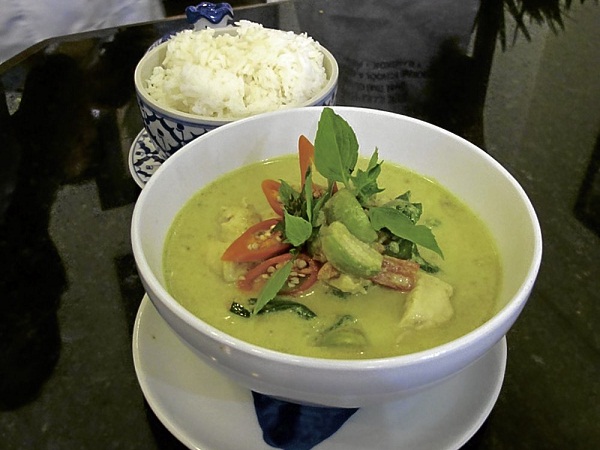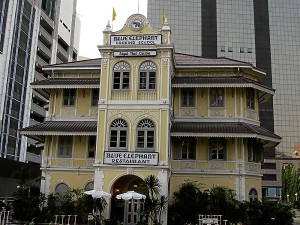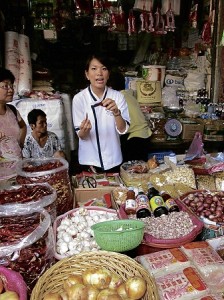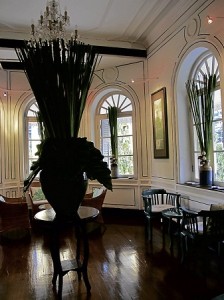
Riding the Bangkok Skytrain, I had seen it on many occasions: a lovely structure with delicately decorated awnings, obviously from a different age. I would eventually find out that it housed a well-known institution—the Blue Elephant Cooking School.
I resolved to enroll in a class just to experience studying in such distinguished premises.

I, like many Filipinos, have long been familiar with Thai food. Yet, we are blissfully unaware that we don’t pronounce the word “Thai” quite correctly.
This point was made clear to me one day on the beach with a group of friends from different parts of the world. When the conversation turned to where we would go for dinner that evening, I piped up: “I think that I would like some Thai.”
Everyone laughed. I was initially puzzled until a physician from Boston called out: “I wouldn’t mind having some arm myself!”
It was only then that I understood what has always been a source of amusement for others: Filipinos tend to say “thigh” when we mean “Thai”. Apparently, the “h” in the latter is supposed to be silent.
Starter kit
The other issue that is often raised is why Thai food is so popular all over the planet while our own cuisine is not.

Numerous theories have been advanced to account for this. Someone even confided that the Thai government will provide potential restaurant owners with a starter kit. I have never verified this but the prospect is certainly intriguing: how to run a Thai cafe all in one box!
With so many more questions to resolve, I decided to grab the bull by the horn—or should I say by the thigh? The next time I was on vacation in Bangkok, I emailed application to a morning course at the Blue Elephant. I was promptly accepted.
On the appointed day, I took the Skytrain to my school, getting off at the Surasak station. Entering the grounds, I saw again the magnificent main building, its three elegant floors rising to the heavens, defying the surrounding skyscrapers.
It was almost inconceivable that there was a time its fate hung in the balance.
The book, “Heritage Houses of Thailand,” recounts how this gorgeous structure, which had been occupied by the Chinese Chamber of Commerce, was the subject of a raging debate.
Some sectors wanted to tear it down, saying it blocked the view of office towers. Others even opined that the building was not in the Thai style anyway and, therefore, no great loss.
What this last argument ignored was how the edifice represented the blending of East and West, very much like the palaces of the Royal Family.

Fortunately, the conservationists won the day, and I was given the pleasure of exploring this splendid survivor of a previous epoch.
My eyes were soon feasting on floors of broad polished planks, gleaming banisters, and huge windows topped with lacy fretwork lunettes. There was a merchandise nook displaying a galaxy of packaged mixes and sauces for sale.
I ascended the staircase to the upper floor where I was ushered into a cool waiting room with paintings of lotus blossoms on the wall as well as celadon-colored furniture.
Outside was a large dining hall already set for meals.
The building evidently housed many enterprises: a restaurant and bar, a cooking school, and a store for condiments.
What an incredibly productive way to reuse a heritage structure!
The school was on the top floor. Here we were given our introductory overview of the course.
As I looked around, I noted that, though it was a weekday, there were about 10 of us in the class. At roughly 3,800 pesos per student and factoring in afternoon sessions, calculating the total take for a year resulted in a princely sum!

This just proves that, when properly utilized, historical buildings can help generate substantial incomes.
Our first activity would be a visit to the market. I found this quite refreshing—an indication of the unapologetic confidence the Thais have about the intrinsic charm of their own way of life. I couldn’t imagine one of our gastronomic gurus leading a clutch of matrons through the teeming meat stalls of Nepo-Q Mart.
I was especially impressed to find that at the very center of the entire commercial complex was an enclosure containing a sacred shrine. Evidently, for the Thais, prayer was not isolated from shopping.
Cooling scents
The tour began with an introduction to the produce of the Siamese countryside. Much of what was being sold was quite familiar to me as we had them in the Philippines too.
My favorites were the green vegetables. I saw dark viridian leaves jostling with frilly lettuce made translucent by the sun. I breathed deeply the cooling scents of coriander and mint.
After the vegetables, it was time for the elements which added fire to Thai food. I learned that there were many types of chili, some small but extremely potent, others larger and almost mild.

There was, as well, a variety of fish sauces from different parts of the country, each with its own distinct blend and resulting kick. I fell to thinking again about why it was that the cuisines of Thailand and the Philippines may work with the same materials, but the former is more globally accepted.
As a special treat, we were brought to the market coffee stall. I watched, fascinated, as the patrician-looking lady behind the counter concocted her brew with an elegance that would be the envy of any accomplished barista. Admittedly, part of my fascination had to do with the fact that what she was using as a strainer looked like an old sock!
Back in the air-conditioned comforts of the school we were welcomed with moist, lightly scented towels, a most appreciated gesture. We were then herded to the lecture room where a cheerful chef demonstrated how each item on our list was prepared.
We also received a schedule for the morning, a recipe book and an apron.
The dishes being showcased were quite straightforward to make. For example, shrimp cakes—one of my favorites—were confectioned from nothing more than a basic paste, eggs, and some chopped vegetables, then deep-fried.
After the lecture, we trooped to the cooking room which consisted of 12 stations, each one furnished with a gas range as well as a counter stocked with ingredients.
Given the few minutes we were allotted, I could barely manage to throw the tasty bits into my pan and begin sautéing. The kitchen instructors had to constantly come to my rescue.
With a mixture of abbreviated English and sign language I was politely but firmly informed that I had to be more alert if my career as a Thai chef were to ever take off.
Later, however, things took a more pleasant turn: I opted to watch serenely as the instructors did all the culinary exertions for me!
By noon we were done. After we had freshened up, we went to the dining room where the results of our labors had been laid out on the table. It turned out that everything I had produced tasted a little flat.
Clearly, there was more to Thai cooking than what had just been explained.
Gracious vintage
Of course, what was lacking in my dishes was no fault of the school. For food is an art. Each one must fashion her own creation with a personal selection of spices and ingredients. There was still much for me to learn.
My Blue Elephant experience did give me some insights into the debate on why Thai, and not Filipino. I saw that part of the answer had to do with the Thais’ understanding that what is truly attractive to a global audience are simplicity and freshness, not elaborate sauces nor complicated techniques.
This understanding accounts for the emphasis on vegetable dishes largely absent from Philippine menus.
The gracious vintage setting of our cooking school also made it clear that cuisine and heritage went hand and hand. For it is history itself which, after all, helps enhance the flavor of every spoonful.
Send all comments and questions to [email protected].








































